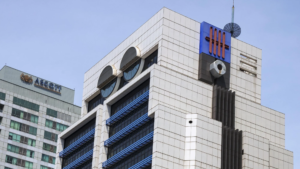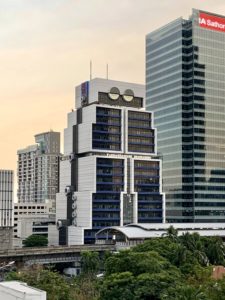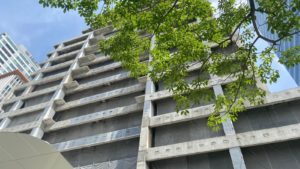
‘Lost its soul’: Campaigners decry renovation of Thailand’s iconic ‘Robot Building’
Architect Sumet Jumsai’s Robot Building, in downtown Bangkok, was designed to reflect the computerization of the banking sector.
For almost four decades, its cartoonish eyes gazed out placidly over Sathorn, a commercial district in downtown Bangkok. Now, with its facade stripped back to a concrete frame amid major renovations, the tower affectionately known as the “Robot Building” is barely recognizable, save for its characteristically blocky silhouette.
The building’s owners, the Thai arm of Singapore’s United Overseas Bank (UOB), say the refurbishment will make its headquarters more energy-efficient and employee-friendly. While the company would not share images of the proposed redesign with CNN, conservationists and architects — including the tower’s 84-year-old designer, who says he was shown plans for the new exterior — have expressed dismay at dramatic alterations being made to an icon of Southeast Asian postmodernism.
Completed in 1986, the Robot Building was intended to reflect changes in the banking industry, which at the time was embracing new computer technology. Its designer Sumet Jumsai, who was inspired by one of his son’s toy robots, is considered a major figure in contemporary Thai architecture, and was named a “national artist” by the country’s government.
In an email to CNN, Sumet, who is now retired, decried the “defacement” of his creation. He described renovations as a “devastating statement” demonstrating the “ignorance and arrogance (of) big corporations.”

The Robot Building pictured in 2022, shortly before the tower’s exterior was stripped as part of ongoing renovations.
Chainwit./Wikimedia Commons
In March, the architect wrote to UOB Thailand expressing concern over the loss of the tower’s “original iconic features,” including its eyes, and urging it to reconsider plans “before it is too late.” The bank’s response, which was shared with CNN by Sumet, acknowledged that the building was a “significant landmark” — but said the planned refurbishment would bring it “into a new era while paying homage to its heritage.”
The bank added that it will keep a replica of the building’s original form in “a corner of the lobby.”
Originally designed for the Bank of Asia, the tower was acquired by UOB Thailand in 2005. The firm told CNN, via email, that its renovations are focused on “promoting environmental sustainability” and “enhancing employee well-being” for the thousands of workers who will occupy the building upon its reopening in 2025.
Bangkok’s abandoned ‘ghost’ towers still stand 20 years after crash
The organization said its redesign will reduce electricity consumption by at least 15%, with a new glass exterior “minimizing the need for artificial lighting and thus reducing associated… carbon emissions.”
‘Elevated’ design
Standing 20 stories high, the Robot Building’s floors get progressively smaller as they rise, giving the structure its distinctive staggered shape. Its iconic lidded “eyes” served as windows for two executive suites on the upper floors, while the building’s toy-like appearance was completed by antennas — used for communications and as lightning rods — and a series of large metallic nuts decorating its sides.
The Robot Building is among a vanishingly small number of landmarks from the era to have survived Bangkok’s breakneck urban development. After recovering from the 1997 Asian financial crisis, Thailand’s capital experienced a building boom that transformed areas like Sathorn. Bangkok is now the world’s 14th tallest city, with 112 towers measuring 150 meters (492 feet) or above, according to the Council on Tall Buildings and Urban Habitat (CTBUH).

The tower’s exterior pictured in August, after renovations began.
Kocha Olarn/CNN
The Thai branch of Docomomo International, a non-profit dedicated to preserving modern architecture, said it has identified the relatively diminutive Robot Building in its upcoming list of the country’s 20 “most outstanding” structures.
In an open letter to UOB Thailand, published in April, the conservation group’s president, Pongkwan Lassus, described the Robot Building as an “historical marker” signaling the transition from late modernism to postmodernism — an architectural movement known for decorative facades, ornamentation and a rejection of the mid-century mantra “form follows function.”
Bangkok-based filmmaker Dana Blouin, who is producing an as-yet-unnamed documentary on the Robot Building, said that despite campaigners’ pleas, the tower has now “lost its soul.”
Tokyo’s iconic Nakagin Capsule Tower to be demolished
“We’ve lost something that was probably more important than anyone realized,” he told CNN via video call.
While recognizing the tower may have been viewed as a “novelty,” Blouin said the original design “felt elevated and refined.” He added: “It was still fun, and it was still whimsical. And it was beautiful.”

John S Lander/LightRocket/Getty Images
“When it was built, it was one of the tallest buildings (in Sathorn district),” he said. “Today, the structure is minuscule by comparison — it’s dwarfed by these other glass and steel structures all around it. And that made it all the more special.”
Shifting attitudes
The filmmaker’s affection may not be shared by many in Bangkok. A petition, started in April by campaign groups including Docomomo, had attracted fewer than 1,700 signatures at the time of writing.
Thailand’s conservation efforts and laws, meanwhile, are mostly directed towards the country’s ancient heritage. Campaigners and architects hope that, while it may be too late for the Robot Building, other important examples of contemporary architecture may be spared a similar fate.
“After nearly two decades of effort, we are beginning to see a shift from the government sector,” reads Pongkwan’s letter to UOB Thailand.
For Blouin, a wider cultural shift is needed if other modern Bangkok landmarks are to be preserved. “The embrace of newness… has led to the forgetting of some of these icons,” he said. “And that’s unfortunate.”
Source: https://edition.cnn.com/style/thailand-robot-building-renovation-bangkok/index.html